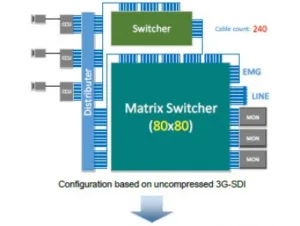Masayuki Miyazaki, Tsuyoshi Sakiyama, Takayuki Yamashita of Japan Broadcasting Corporation (NHK) said that they have developed a Tico (SMPTE RDD35:2016) codec for 8K ultrahigh-definition TV (8K-UHDTV) production. The codec works at a compression rate of 4:1 and the resulting 8K code stream can be transmitted with a single 12G-SDI cable.
Not only is Tico well known for its visually lossless video quality and very low latency, but it is also characterized by a quality degradation that is almost independent of the number of successive encoding/decoding operations, which makes it suitable for production systems.
The bitrate of an 8K uncompressed stream can reach 48 Gb/s (59.94 Hz, 10 bits, 4:2:2). That requires bundling 16 3G-SDI cables, which is very problematic so transmitting 8K content over a single cable is a big deal. The benefits of decreasing the cable count are exponential. NHK estimates that when compared to systems of a comparable scale based on uncompressed 3G-SDIs, the use of the proposed codec will reduce the cable count to less than 1/5th, and the number of cross-points in the matrix switcher to less than 1/200th.
But 8K-Tico content is also suitable for IP interfaces, which is an option that may become mainstream when the problems of interoperability between different formats are overcome, or when unified standards emerge.
Tico Standardized by SMPTE
The authors then gave a little background on Tico, which was developed by IntoPIX and standardized by SMPTE. (IntoPix Tico Enables AV over IP) It is a lossless codec that can be implemented without memory in FPGAs or ASICs. On a 4K image, it segments the image into 34 slices each of 3840 x 64 pixels, which are then encoded and decoded separately. This wavelet-based compression can be done with very little latency.
For 8K images, the idea is to bundle four 4K images and pack them onto the 12G-SDI interface, which works in a similar way – i.e., bundling of 3G-SDI streams.
While there is no clear objective measure of visual losslessness, a PSNR value above 40 typically gets a visually lossless classification. To prove this is so with an 8K Tico encode, NHK zoomed into an encoded/decoded image and compared the magnified details at 100x without seeing any artifacts or impact from the compression/decompression cycle.
NHK built a device that can encode or decode depending on the settings. The 8K uncompressed signal—bundled on 4 × 12G-SDI (SMPTE ST 2082-12)—is compressed by the encoder at a ratio of 4:1, thus producing a Tico code stream output on a single 12G-SDI.
Even when transmitting 8K Tico code streams on a 12G-SDI, the SDI container will be kept; therefore, peripheral equipment such as frame synchronizers, matrix switchers, distribution amplifiers, transmission devices, etc., can be used as if an uncompressed signal was being transmitted.

NHK did PSNR tests on an original image and compared to the encoded/decoded version obtained PSNR values in excess of 40 in all nine test images, with most in excess of 50. A second encode/decode cycle showed no measureable degradation in the PSNR.
NHK would like to see Tico adopted over a number of production equipment categories as this will reduce cabling requirements and make for more compact 8K production centers, like OB vans.
The group is also interested in distributing 8K video over IP, but more work has to be done here. Recently, SMPTE standardized ST-2110 that provides a full suite of standards for video over IP, but 8K, even with light compression, will need 40 GigE switches, which are not mainstream today. (MoIP: Coming to a Cloud Near You)

